Input 2020.12.24 06:00
Hyundai Motor Company (005380)Palisade, Genesis GV80, G80, etc., continue to have so-called’bottlenecks’, with a waiting period of 3 months before delivery of the vehicle after ordering, but the Asan plant, which produces the Sonata model, which has been sluggish in sales, has stopped operating.
It’s under one roof, but depending on the model it produces, some lines don’t keep up with demand even if workers work overtime, while others stop production to digest inventory. Hyundai Motor’s old production methods and vested union egoism lead to a production imbalance.

The GV70, which started contract on the 22nd, is expected to be shipped sequentially from January, but the waiting period is expected to be longer as there is greater demand than the previously released GV80, with orders exceeding 10,000 units on the first day.

The problem is that Hyundai’s production capacity is too rigid to respond to increased demand. Each production line of Hyundai Motors produces only a set model, and even if demand for that model increases, it is virtually impossible to increase production immediately. Because automobiles are produced in a batch assembly method in Korea, it takes a considerable amount of time to replace the production line to make a different model, and labor-management discussions must be made to transfer work to another factory. Workers in charge of producing popular car models are unfavorable to handing over their work to other factories because they can receive additional wages through overtime and overtime.
Because of this, production of popular models is delayed and consumers wait for several months, but factories that produce models with sluggish sales sometimes shut down. This leads to double losses. This is because inefficiency occurs in the production process, and at the same time, consumers who have been waiting for shipment while the production increase is delayed, abandon the contract and purchase another car, leading to consumption churn.

Some changes are happening in Hyundai Motor Company. According to the industry, Hyundai Motor Company is developing a flexible production system that allows one production line to produce different models according to demand. This system will be piloted at the Ulsan plant that produces electric vehicles. An industry insider said, “The union, which knows that changes are necessary to survive, is also actively engaged in discussions on accepting the conversion arrangements,” and said, “There will be a big change in the production method of Hyundai Motors soon.”
